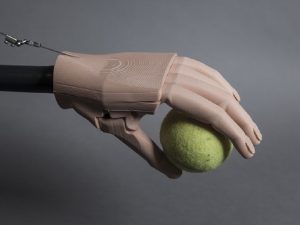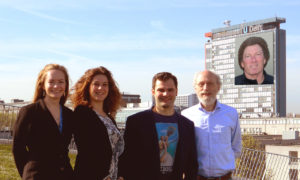The Hand Fund is a young organization and finds several ways to facilitate research for hand and arm prostheses and orthoses. Next to our own projects, we also offer a platform for other projects.
FA3D Hand
 The Functional and Anthropometric 3D-printed hand prosthesis (FA3D Hand) is a novel 3D-printable prosthetic hand. It is the result of the work done by Jelle ten Kate, who developed this device during his Master’s thesis at the Delft University of Technology.
The Functional and Anthropometric 3D-printed hand prosthesis (FA3D Hand) is a novel 3D-printable prosthetic hand. It is the result of the work done by Jelle ten Kate, who developed this device during his Master’s thesis at the Delft University of Technology.
A simple, body-powered hand prosthesis
The FA3D Hand is designed to be used as a body-powered prosthesis, which is controlled using a shoulder strap. The hand can be made using basic (FDM) 3D-printers and standard nuts and bolts. The material costs to create an FA3D Hand sum up to roughly €30.
Print it yourself!
The Hand Fund would like to spread this project by offering the necessary files for download, so anyone with access to a 3D-printer can create an FA3D Hand themselves.
Click here to go to the Thingiverse page for the FA3D Hand, which includes .STL-files that can be printed directly.
Click here to download the SolidWorks files for the FA3D Hand.
Click here to view the thesis report of Jelle ten Kate.
Hand Fund support
The FA3D Hand is an excellent example where 3D-printing technology can help in creating fast, cheap and individualized devices. The Hand Fund recognizes the clear advantages of 3D-printing. But, at the same time, we see that more research is necessary. Do you like this project? You can help us by giving a hand.
DIPO Power
UPDATE: They've done it! DIPO Power has won the 'Arm prosthesis race' at the Cybathlon in Zurich! Bob Radocy from TRS prosthetics overcame all obstacles with his body-powered prosthesis and did this the fastest of all. On behalf of all of us from the Hand Fund: congratulations!

DIPO Power represented Delft University of Technology at the Cybathlon 2016 in Zurich. They participated in the ‘Powered Arm Prosthetics Race’ by using a prosthesis which was 100% driven by body-power.
The Cybathlon
The Cybathlon in 2016 was the first international competition where people with physical disabilities could compete using the latest assistive technology. During the ‘Powered Arm Prosthetics Race’, a dedicated prosthesis user (or ‘pilot’) went through an obstacle course, which contained various tasks that relate to daily activities.
DIPO Power team
DIPO Power was formed by three Master’s students from Delft University of Technology. The unique element of the DIPO Power team was that they used a body-powered prosthesis, which allows for a fast and accurate operation of the prosthesis. Strengthened by their pilot, Bob Radocy from TRS Prosthetics, DIPO Power was determined to optimize their prosthesis and showcase its abilities.
Hand Fund support
Competitions like the Cybathlon are an excellent opportunity to demonstrate the current state-of-the-art in assistive technology, but also challenges researchers and developers to show what they can and encourages close collaboration with prosthesis users. The Hand Fund gladly supported this project and provided DIPO Power with a funding platform to help them reach their goal.
Plans
The Hand Fund strives for solutions that directly benefit the end user of the prosthesis or orthosis. Below, a few projects are described which we believe directly correspond to this goal. We would therefore like to bring these projects into practice.
3D-printing prostheses
Worldwide, there are many initiatives in making new prostheses using 3D-printing technology. This new technology offers the possibility to adjust the shape and color for every individual prosthesis. Already you can find many different designs across the internet. However, it is hard to find out which designs are good and which are not. The first impression is often positive, but unfortunately a lot of 3D-printed prostheses break down fast and parts often have to be printed again. We would like to facilitate research into which 3D-printed prostheses give the most advantages for the user. Additionally, we would like to know for which situations 3D-printed prostheses can provide for a good addition to already existing prostheses.
Available forces with body-powered prostheses
Body-powered prostheses have the advantage that the applied forces can be directly felt in the shoulder harness. There is, however, not much known about the available forces from the user of the prosthesis. For example, what is the limit, what is comfortable and which movements are ideal? The Hand Fund would like to find the answers to these questions, because they can improve the control of the prosthesis. Moreover, they can also provide for guidelines for the many components that affect the force transmission in the overall system. All these factors influence the way the end user experiences the prosthesis. For this reason, we are convinced that doing research to these issues is crucial, hence we would like the provide the resources necessary to make this possible.
Measuring grip forces
One of the main functions of a hand prosthesis or orthosis is the ability to grip objects. However, it is difficult to determine what grip forces are really necessary, resulting in many products that are designed to provide too high forces and therefore require too much energy. We would like to change this to a situation where the use of a prosthesis or orthosis more resembles the natural functionalities of the human hand. The exact amount of grip force is determined by many different factors, amongst others the combination of materials between the prosthesis/orthosis and the object. For example, the cosmetic glove of a prosthesis or leaving the palm of the hand free with an orthosis can therefore make a great difference. In order to get a good view on what grip forces are necessary, a lot of combinations of materials and surrounding factors need to be tested. The Hand Fund would like to contribute to such measurements by providing with the necessary resources.
